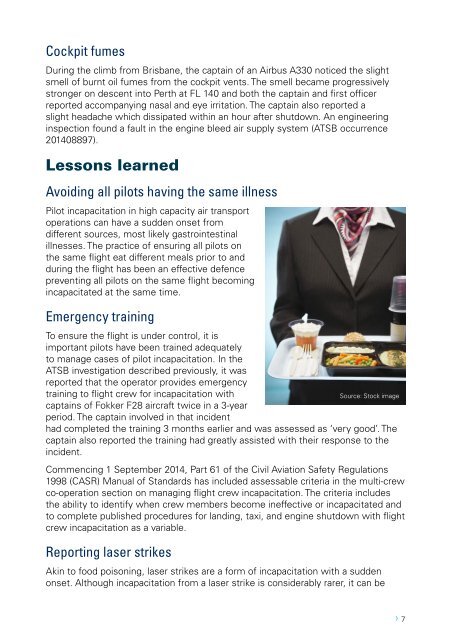Pilot incapacitation occurrences 2010–2014
8rKXy6YKY
8rKXy6YKY
Create successful ePaper yourself
Turn your PDF publications into a flip-book with our unique Google optimized e-Paper software.
Cockpit fumes<br />
During the climb from Brisbane, the captain of an Airbus A330 noticed the slight<br />
smell of burnt oil fumes from the cockpit vents. The smell became progressively<br />
stronger on descent into Perth at FL 140 and both the captain and first officer<br />
reported accompanying nasal and eye irritation. The captain also reported a<br />
slight headache which dissipated within an hour after shutdown. An engineering<br />
inspection found a fault in the engine bleed air supply system (ATSB occurrence<br />
201408897).<br />
Lessons learned<br />
Avoiding all pilots having the same illness<br />
<strong>Pilot</strong> <strong>incapacitation</strong> in high capacity air transport<br />
operations can have a sudden onset from<br />
different sources, most likely gastrointestinal<br />
illnesses. The practice of ensuring all pilots on<br />
the same flight eat different meals prior to and<br />
during the flight has been an effective defence<br />
preventing all pilots on the same flight becoming<br />
incapacitated at the same time.<br />
Emergency training<br />
To ensure the flight is under control, it is<br />
important pilots have been trained adequately<br />
to manage cases of pilot <strong>incapacitation</strong>. In the<br />
ATSB investigation described previously, it was<br />
reported that the operator provides emergency<br />
training to flight crew for <strong>incapacitation</strong> with<br />
Source: Stock image<br />
captains of Fokker F28 aircraft twice in a 3-year<br />
period. The captain involved in that incident<br />
had completed the training 3 months earlier and was assessed as ‘very good’. The<br />
captain also reported the training had greatly assisted with their response to the<br />
incident.<br />
Commencing 1 September 2014, Part 61 of the Civil Aviation Safety Regulations<br />
1998 (CASR) Manual of Standards has included assessable criteria in the multi-crew<br />
co-operation section on managing flight crew <strong>incapacitation</strong>. The criteria includes<br />
the ability to identify when crew members become ineffective or incapacitated and<br />
to complete published procedures for landing, taxi, and engine shutdown with flight<br />
crew <strong>incapacitation</strong> as a variable.<br />
Reporting laser strikes<br />
Akin to food poisoning, laser strikes are a form of <strong>incapacitation</strong> with a sudden<br />
onset. Although <strong>incapacitation</strong> from a laser strike is considerably rarer, it can be<br />
› 7


